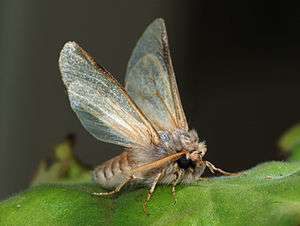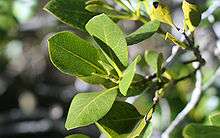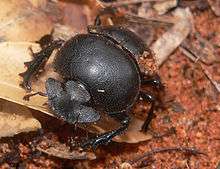Geographic range limit
A geographic range limit is the geographic boundary beyond which a species does not occur, the limit or limits of the range of a species. "Core populations" are populations of individuals occurring within the center of the range, and "peripheral" or "edge populations" are groups of individuals near the boundary of the range.
The inability of a species to expand its range beyond these limits is because of some factor or factors that constrain the species from adapting to overcome the factors that are imposing limits on its distribution.[1] In some cases, geographical range limits are entirely predictable, such as the physical barrier of an ocean for a terrestrial species.[1] In other cases, reasons why species do not pass these boundaries are unknown, however the main determinants of the distribution of a species across its range are ecological and evolutionary processes.[2]
For many species of invertebrate animals, the exact geographic range limits have never been precisely ascertained, because not enough scientific field work has been carried in many parts of the world to map distribution more precisely, therefore finding a range extension for species, especially marine species, is not an uncommon occurrence.
Abiotic factors

Gradients in climactic factors create physiological barriers to dispersal.[1] All species have limits of tolerance to abiotic factors, which can lower their survival and reproductive success and limit range expansion beyond the edge. Changes in temperature may cause a species to change its geographical distribution. With increasing temperatures resulting from global warming, species have been seen to expand their range northward due to increased survival and reproduction as a result of warming.[3] Precipitation can also be a key determinant in limiting the geographic range edges of species. This is often seen in organisms with high water demands, whose survival and reproduction would decrease beyond the edge due to dry conditions, limiting expansion.[4] Moisture of soil or air is also seen to limit range expansion. In terms of soil moisture, limited range expansion for species that forage on soil organisms or for species that reside in soil and rely on it for nutrients are seen.[5] If moisture requirements are not met beyond the species range, they will not be able to expand due to resulting reductions in fitness. There are many other abiotic factors that can determine a species range, including dissolved oxygen, canopy cover, conductivity, alkalinity and pH.[6]
Biotic factors

Interactions between species can cause limitations to a species geographic range. The most obvious interaction that limits range expansion is predation, where prey species do not move beyond their range to avoid predator attack and mortality.[7] Geographic range edges can also be determined by competition, where less competitive species are forced into suboptimal conditions within the range to avoid stress of reduced food and habitat.[7] The geographic range of one species may be linked to another, where the range of one species cannot extend independent of the other. This is seen in mutualistic relationships, where fitness and population growth are reduced outside of the hosts range where the symbiont is not present.[8] Parasitism can also play a role in limiting the expansion of species outside of their range. This occurs when there is a higher presence of infection at the range edges that reduces population growth and survivorship and ultimately reduces further expansion.[9] Higher parasite presence can occur when abiotic conditions are unfavorable at the edge, leading to lower resistance of species to the infection.[9]
Anthropogenic factors
.jpg)
Humans are responsible for causing changes to the environment and habitat that plants and animals rely on for survival. These impacts have the potential to alter species behaviours, interactions and distributions. Many areas are deforested in order to provide land for agriculture or industrial use. Deforestation can cause loss of habitat for millions of species and can cause expansion or contraction of their geographic range.[10] For species that require deforested land, they may expand in their range to take advantage of new habitat, however for species that require forest for survival their geographic range may decrease or change completely. the Global warming resulting from green house gases emitted into the air has been seen to cause changes in species dispersal and geographic distribution.[11] Due to rising temperatures, organisms move northward to reach slightly colder temperatures to track the environmental niche they are adapted to.[11] This allows them to continue stable survival and reproduction and ultimately sustain their population. Humans have also initiated many range expansions by transporting species to new locations both intentionally and accidentally.[12] These introduced species can survive and reproduce in these new locations and expand their geographic range as long as conditions are suitable. These species may also cause changes in the geographic range of native species that cannot tolerate competition from invasive species, who possess novel ways of using resources.[12]
Genetic factors

Studies of the genetic influences on geographic range limits tend to focus on genetic effects that restrict peripheral populations from expanding beyond their range edge. Many hypotheses have been proposed, however there has not been a general consensus on one main cause. Most hypotheses stem from the fact that peripheral populations are expected to be small, due to less optimal conditions at the edge.[13] One hypothesis predicts that due to smaller population size at the edge, genetic drift will have a larger effect and reduce genetic variation of edge populations.[14] With less genetic variation, populations at the edge may have difficulty adapting to changing conditions.[13] Another hypothesis predicts that high selection pressure at the peripheral edge will only allow for a few genotypes to survive, decreasing genetic variation and future adaptation.[14] Reduced gene flow between central and peripheral populations has also been hypothesized as a limitation for species expansion. Without introduction of new alleles from central to edge populations, genetic variation will remain low and peripheral populations will have difficulty adapting to new conditions.[14] Contrary to this, some hypothesize that gene flow between central and peripheral populations can prevent range expansion, where gene flow causes contamination of the edge gene pool.[15] Conditions at the center of the range differ from those at the periphery; therefore adapted alleles at the center may not benefit those at the edge who experience different conditions.[15] The Allee effect has also been proposed to reduce range expansion, where small population sizes lead to reduced cooperation and survival.[16] There are many potential causes of the allee effect, including mate-finding failure or inbreeding.[17] At low densities, the challenge for males and females to locate each other is much larger, leading to decreased reproduction and survival.[17] Small population sizes may also cause species to mate with their relatives, increasing chances of lethal alleles within the population and decreasing survival.[17]
Combined influences

In most cases, combinations of factors are responsible for limiting the geographic range edge of species. Abiotic and biotic factors may work as co-factors in determining the ability of species to expand their range. This is found in obligate seeder plants, who require fire to activate their seed bank and produce seeds, and require mediated dispersal of seeds by other species to expand their range.[18] This can also be seen in species that share an overlapping range, where competition for food and habitat determines where each species resides.[19] Abiotic and anthropogenic factors can be found to work together to limit a species range. Deforestation can result in climate change, where reduced protection from sun blocking tree cover causes forest soils to lose moisture and dry out.[20] Species that live in soil or forage on soil living species require moisture for survival, therefore changes in their geographical distribution may occur if these conditions are not met.[20] Genetic factors can interplay with abiotic and or biotic factors as determinants of a species range, where unfavorable conditions can reduce fitness and survival of species, limiting their distribution.[21]
See also
References
- Mott, CL (2010). "Environmental Constraints to the Geographic Expansion of Plant and Animal Species". Natural Education Knowledge. 3 (10): 72.
- Hardie, DC; Hutching JA (2010). "Evolutionary ecology at the extreme of species' ranges". Environ. Rev. 18: 1–20. doi:10.1139/a09-014.
- Battisti, A; Stastny M; Netherer S; Robinet C; Schopf A; Roques A; Larsson S (2005). "Expansion of geographic range in the pine processionary moth caused by increased winter temperatures". Ecological Applications. 15 (6): 2084–2096. doi:10.1890/04-1903. S2CID 85727778.
- Bateman, BL; Abell-Davis SE; Johnson CN (2011). "Climate-driven variation in food availability between the core and range edge of the endangered northern betting (Bettongia tropica)". Australian Journal of Zoology. 59 (3): 177–185. doi:10.1071/zo11079. S2CID 18311626.
- Duckworth, G; Altwegg R; Guo D (2010). "Soil moisture limits foraging: a possible mechanism for the range dynamics of the hadeda ibis in southern africa". Diversity and Distributions. 16: 765–772. doi:10.1111/j.1472-4642.2010.00683.x.
- Neff, MR; Jackson DA (2011). "Effects of broad-scale geological changes on patterns in macroinvertebrate assemblages". Journal of the North American Benthological Society. 30 (2): 459–473. doi:10.1899/10-052.1.
- Holt, RD; Barfield M (2009). "Trophic interactions and range limits: the diverse roles of predation". Proc. R. Soc. B. 276 (1661): 1435–1442. doi:10.1098/rspb.2008.1536. PMC 2677217. PMID 19324814.
- Stanton-Geddes, J; Anderson C (2011). "Does a facultative mutualism limit species expansion?". Oecologia. 167 (1): 149–155. doi:10.1007/s00442-011-1958-4. PMID 21380848.
- Briers, R (2003). "Range limits and parasite prevalence in a freshwater snail". Proceedings of the Royal Society of London. 270 (Suppl 2): 178–180. doi:10.1098/rsbl.2003.0046. PMC 1809944. PMID 14667375.
- Kostecke, RM; Ellison K; Summers SG (2004). "Continued range expansion by bronzed cowbirds in the southwestern united states". The Southwestern Naturalist. 49 (4): 487–492. doi:10.1894/0038-4909(2004)049<0487:crebbc>2.0.co;2.
- Crozier, L (2004). "Warmer winters drive butterfly range expansion by increasing survivorship". Ecology. 85 (1): 231–241. doi:10.1890/02-0607.
- McNeil, JN; Duchesne R (1977). "Transport of hay and its importance in the passive dispersal of the European skipper, Thymelicus lineola (Lepidoptera:Hesperiidae)". Can. Ent. 109 (9): 1253–1256. doi:10.4039/ent1091253-9.
- Brown, JH (1984). "On the relationship between abundance and distribution of species". The American Naturalist. 124 (2): 255–279. doi:10.1086/284267.
- Dai, Q; Fu JZ (2011). "When central populations exhibit more genetic diversity than peripheral populations: a simulation study". Chinese Sci Bull. 56 (24): 2531–2540. doi:10.1007/s11434-011-4605-x.
- Kirkpatrick, M; Barton NH (1997). "Evolution of a species' range". American Naturalist. 150 (1): 1–23. doi:10.1086/286054. PMID 18811273.
- Allee, WC; Bowen E (1932). "Studies in animal aggregations: mass protection against colloidal silver among goldfishes". Journal of Experimental Zoology. 61 (2): 185–207. doi:10.1002/jez.1400610202.
- Tobin, PC; Robinet C; Jhonson DM; Whitmire SL; Bjornstad ON; Leibhold AM (2009). "The role of Allee effects in gypsy moth, Lymnatria dispar (L.), invasions". Popul Ecol. 51 (3): 373–384. doi:10.1007/s10144-009-0144-6.
- Arnan, X; Rodrigo A; Molowny-Horas R; Retana J (2010). "Ant-mediated expansion of an obligate seeder species during the first years after fire". Plant Biology. 12 (6): 842–852. doi:10.1111/j.1438-8677.2009.00294.x. PMID 21040299.
- Hersteinsson, P; Macdonald W (1992). "Interspecific competition and the geographical distribution of red and arctic foxes Vulpes vulpes and Alopex Lagopus". Oikos. 64 (3): 505–515. doi:10.2307/3545168. JSTOR 3545168.
- Larsen, TH (2012). "Upslope range shifts of Andean dung beetles in response to deforestation: compounding and onfounding effects of microclimactic change". Biotropica. 44 (1): 82–89. doi:10.1111/j.1744-7429.2011.00768.x.
- Stanton-Geddes, J; Tiffin P; Shaw RG (2012). "Role of climate and competitors in limiting fitness across range edges of an annual plant". Ecology. 93 (7): 1604–1613. doi:10.1890/11-1701.1. PMID 22919907.